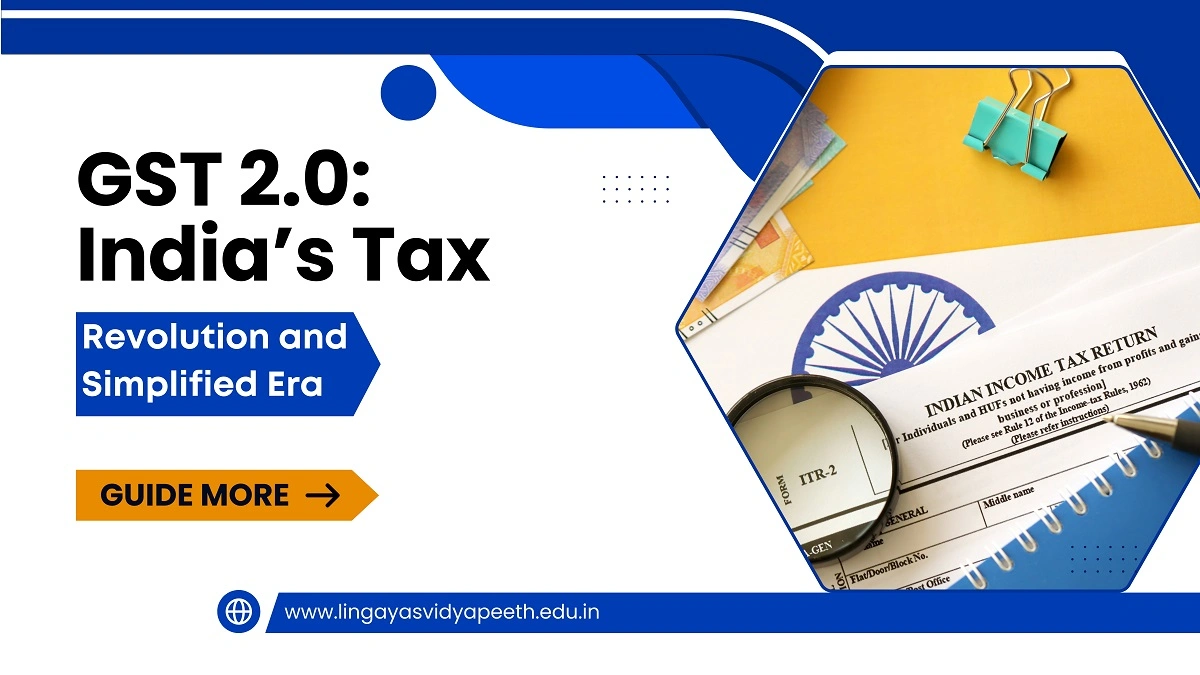Home » GST 2.0: India’s Tax Revolution and Simplified Era

On September 22, 2025, India will roll out GST 2.0 — the biggest change to the Goods and Services Tax (GST) since 2017. Approved by the GST Council on September 3, 2025, this tax reform aims to make indirect taxation simpler, clearer, and more efficient for both businesses and consumers. The reform combines rate rationalization with technology and process upgrades across the GST portal, GST compliance and return filing.
GST 2.0 is a clean break from the previous, more complex multi-slab design. Under the new plan:
This GST slab rationalisation addresses a core complaint of the original GST: frequent classification disputes. Businesses often argued over whether an item (for example, a chocolate-biscuit) belonged in 18% or 28%. The new design creates clearer categories for necessity, standard, and luxury goods, reducing classification confusion and boosting tax transparency.
By drawing firmer lines between essentials and luxuries, GST 2.0 reduces disputes over tax classification, helps businesses plan pricing, and gives consumers more stable prices.
The revamped GST operates on three main rates:
A 0% exemption still applies to basic food grains, certain healthcare services, and education materials. The new 40% demerit rate replaces the previous mix of 28% + cess on luxury and sin goods, simplifying pricing and removing the administrative need to manage both GST and separate cess components.
GST 2.0 is expected to affect inflation and growth:
These estimates come from how lower prices can lift demand, and how simpler GST compliance and lower litigation can improve business investment.
GST 2.0 aims to cut compliance cost and complexity:
A formal appeals body, the Goods and Services Tax Appellate Tribunal (GSTAT), is expected to be functional by December 2025. GSTAT should shorten dispute timelines and lower litigation costs, giving businesses more certainty for planning and investment.
Many household staples — packaged foods, soaps, domestic appliances, and healthcare products — will move down to 5% or 18% from higher rates. That should help household budgets, especially for middle-class families.
Short-term caveat: retailers may not immediately pass the full tax benefit to consumers because they hold inventory bought at older, higher GST rates. Clearing existing stock will take time, so full price relief may be phased in during the transition.
A smooth transition will need careful handling:
Logistics, IT changes (price lists, POS updates), and staff training will be crucial for retailers and manufacturers during the switch.
GST 2.0 pairs rate changes with digital upgrades:
Together, these tech changes reduce disputes and make compliance more predictable and cheaper.
GST 2.0 is more than a rate change — it’s a move to a business-friendly, transparent tax system. The real test will be delivery: whether simplification actually lowers compliance costs, improves tax collection without hurting revenue sufficiency, and boosts competitiveness.
The coming months (post-September 22, 2025) will show how quickly businesses adapt and whether consumers get lasting relief. Early signs are promising, but stable results depend on smooth implementation and stakeholder cooperation.
GST 2.0 builds on eight years of GST experience. By choosing simplicity over complexity and transparency over uncertainty, the reform aims to make India’s indirect tax system a driver of economic growth — not just a revenue machine. Success will depend on clear rules, fast tech upgrades, and cooperation from businesses and consumers.
Also Read
Best Law courses after 12th
Difference between advocate and lawyer
Career options after Law
Online Gaming Bill 2025: Know About India’s New Gaming Law
From
Sweksha Bhadauria
Assistant Professor
School of Law
RECENT POSTS
CATEGORIES
TAGS
Agriculture Agriculture future AI Architecture artificial intelligence Bachelor of Commerce BA English BA Psychology BTech AIML BTech CSE BTech cybersecurity BTech Engineering Business management career Career-Specific Education career guide career option career scope Civil engineering commerce and management Computer Science Computer science engineering Data science degree education Engineering Engineering students English Literature english program Fashion Design Fashion design course Higher Education Journalism journalism and mass communication law Law career Machine Learning mathematics MBA MBA specialization Mechanical Engineering Pharmacy Psychology Research and Development students
Nachauli, Jasana Road, Faridabad, Haryana
Address: C-72, Second Floor, Shivalik, Near Malviya Nagar,
Above HDFC Bank, New Delhi 110017
Landline No. - 011-46570515 / 45138169 / 41755703
Mobile No. - +91-7303152412 / +91-7303152420 / +91-9311321952
Toll Free: 1800-120-4613
Mobile : 8447744303 | 8447744304 | 8447744306 | 8447744309
8700003974 | 8700003411 | 8700003749
Copyrights © 1998 - 2025 Lingaya's Vidyapeeth (Deemed To Be University). All rights reserved.
LV only conducts physical/online verification of any document related to examination on the following email id:
It is important to note that the following email IDs and domains are fraudulent and do not belong to our university.